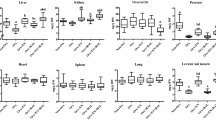Abstract.
We investigated the effects of conjugated estrogens as an add-back replacement drug, incadronate sodium as a bisphosphonate, and alfacalcidol as a vitamin D3 analog on femoral bone mineral density (BMD) and bone mineral content (BMC) in female rats chronically treated with the gonadotropin-releasing hormone (GnRH) agonist leuprorelin acetate. The chemical castration of the rats by the administration of GnRH agonist for 16 weeks reduced the BMD values to 92.3%, 91.3%, and 93.3% of those of the normal control animals in the whole femur, metaphysis, and diaphysis of the femur, respectively. The BMC value was decreased to 91.0% of that of the normal control animals by the chronic GnRH agonist treatment. However, a simultaneous 8-week administration of conjugated estrogens, bisphosphonate, and vitamin D3 analog markedly augmented the BMC values to 110.3%, 110.1%, and 114.4%, respectively, of those in the rats treated with the GnRH agonist alone. These findings indicate that antiosteoporotic agents could be useful for preventing induced osteopenia under the careful monitoring of biochemical markers of osteoblastic activity or bone resorption and BMD or BMC in patients undergoing GnRH treatment.
Similar content being viewed by others
Author information
Authors and Affiliations
Additional information
Received: 8 December 1998 / Accepted: 10 February 1999
Rights and permissions
About this article
Cite this article
Sakamoto, S., Sassa, S., Mitamura, T. et al. Prevention of Osteopenia Induced with a Gonadotropin-Releasing Hormone Agonist in Rats. Calcif Tissue Int 65, 152–155 (1999). https://doi.org/10.1007/s002239900675
Issue Date:
DOI: https://doi.org/10.1007/s002239900675




